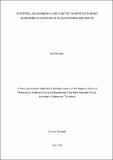| dc.description.abstract | The performance of experimental batch-reactor loaded with slaughterhouse waste at mesophilic
temperature was investigated as well as the inhibition of both ammonia and sulfide in the
aqueous phase during phase I of anaerobic digestion. The methylene blue method was used to
quantify the amount of sulfide in the liquid phase whereby the amount of total ammonia
nitrogen in the liquid phase was quantified by using Nessler method. The maximum CH
4
content of 69.6% was achieved at 0.37 VFA/Alkalinity ratio and pH of 7.51 during day 37 of
anaerobic digestion. However, a sudden increase of ammonia nitrogen in the digester from day
44 to day 68 decreased the methane content by 62.15% from 65% to 24.6%. During phase II of
anaerobic digestion, the efficacy of inorganic additives on the removal of total ammonia
nitrogen and sulfide in the aqueous phase of slaughterhouse waste undergoing anaerobic
digestion in the batch reactor was investigated for 65 days. A mixture of natural inorganic
additives processed from the anthill and red rock soil samples collected from Arusha, Tanzania
were used as adsorbents in different ratios. XRD analysis revealed that the anthill soil sample is
endowed with quartz and hematite major mineral phases while red rock soil contains albite,
pyroxene, and quartz as predominant phases. The anthill and red rock soil samples calcined at
900 ℃ displayed higher BET surface areas of 815. 35 and 852.35 m
2
/g, respectively. Among
all the adsorbent ratios investigated at different calcination temperatures, the ratio of 1:1 and
calcination temperature of 700℃ produced the highest adsorption capacities of both TAN and
sulfide. Adsorption isotherm studies revealed that Jovanovich model fitted better to the
experimental data than Langmuir and Freundlich models. The findings of this study have
demonstrated that anthill and red rock soils can be exploited as affordable, ecofriendly and
efficient adsorbents for mitigation of TAN and sulfide from the liquid phase and sustenance of
methanogenesis. | en_US |

